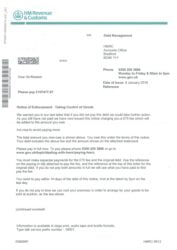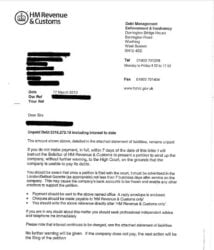HMRC Bailiffs and Enforcement Officers – Can They Enter My House?
A Bailiff, HMRC officer or an Enforcement Officer has the power to take control of your goods and possessions in order to satisfy a debt.
ReadHMRC Bailiffs and Enforcement Officers – Can They Enter My House?
A Bailiff, HMRC officer or an Enforcement Officer has the power to take control of your goods and possessions in order to satisfy a debt.
ReadSecured And Unsecured Creditors – What Is The Difference?
I am confused about secured and unsecured creditors. What is the difference? As a director of a company that is doing well and making money you may have no real understanding about the important differences between certain types of creditors. The only time it really comes up is if you apply for a loan for the business and the lender talks about security and the loan being secured etc. Secured Creditors A secured creditor is a creditor that has security over an asset or assets of the company. So, if the company can't pay then they have the right to the proceeds of the sale or proceeds of the asset. This is enabled by a legal document called a charge or debenture. There are two kinds of charge; A Fixed Charge and a Floating Charge. The difference is quite hard to explain in a few words so we have a dedicated page on the differences. Have a read here on fixed and floating charges. A fixed charge is essentially a charge on a very specific asset whereas a floating charge is across a range of assets or asset that can change.A charge is a bit like a mortgage on your house. If you fail to keep up your payments then the bank can effectively force the sale of the asset and reimburse themselves. In a company situation if the secured lender is owed money then they can "force" the company into the hands of administrators who will pay them having sold the assets. This description is simplistic and is more akin to the old system of receivership but it illustrates the principal. Unsecured Creditors These are essentially creditors that have no security over the assets. This can be a trade supplier, HMRC, a utility company. Banks will often lend without security but they will charge a higher rate of interest to offset the risk they can't get their money back.Be aware though that some creditors are called secured as they have a personal guarantee from the director and they may use terminology like "secured against the directors personal assets" In insolvency law they are not secured and so come after the secured creditors that have a "charge" over the company's assets when money is paid over in the event of a terminal insolvency event like liquidation. What about defacto secured creditors? These are creditors that do not have any security over the company's assets but they have control over the company in that they can shut it down. An example might be the creditor that runs their proprietory software, or their means of payment (this happens when Amazon have lent the company money to develop their online shop) such creditors are more properly referred to as "ransom creditors". Ransom creditors are more important if the company is insolvent but could be rescued and so need to continue to trade. So they need to be kept happy!In a liquidation scenario they would be behind a secured creditor that had a charge over the stock for example.For a more detailed explanation of the priority of creditors in an insolvency situation then please look at our page on creditor priority. There is even a handy infographic on there too.
Read
What is an HMRC Notice Of Enforcement?
Any creditor who is owed money has the power to serve a Notice of Enforcement if they obtain a court order. HMRC or landlords do not need a court order, however they must still obey strict regulations to retrieve debt.
ReadA landlord’s and tenant’s guide to commercial rent arrears recovery (CRAR)
For the better part of 250 years, landlords enjoyed the right to claim ‘distress’ for unpaid rent – meaning that they could seize (distrain) and sell their tenants’ goods to recoup the loss of earnings.The Rent Act 1977 stripped this right from residential landlords1, but commercial landlords continued to be able to exercise distraint until April 2014, when distress laws were replaced with the commercial rent arrears recovery (CRAR) process2, 3. So what exactly is CRAR? Like most archaic UK legislation, distress law was unnecessarily complicated and, many felt, rather unfair. The CRAR rules that supersede them are intended to be simpler and more balanced, with a greater focus on tenants’ rights than their predecessors.CRAR still allows a landlord to collect overdue rent without the need for a court order; however, it applies only to commercial tenancies, and the tenancy must be subject to a written lease. It can only be used to recover rent and any interest and/or VAT payable under the terms of the lease. Landlords: enacting the CRAR procedure Before claiming unpaid rent from a commercial tenant, you must remember the following:The arrears must be at least seven days’ worth or more at the time the notice is served and at the time of enforcement You do not have the right to seize your tenant’s goods yourself; they can only be seized by a certified enforcement agentOnce you have found an authorised enforcement agent, you will need to fill out a Warrant of Control form to enable them to begin enforcement action. The enforcement agent will then take over the process, issuing a seven day notice to your tenant in the first instance.If the rent remains unpaid at the time of enforcement, the agent will enter the property and take control of certain goods located thereon to be sold at public auction. Tenants: your rights under CRAR Firstly, you must remember that a notice of enforcement binds goods to remain on the property, meaning you cannot sell or remove them. You can, however, delay enforcement by applying to court for a delay of execution or a set aside.It is possible to enter a controlled goods agreement in order to repay what you owe over time. Under such an agreement, the goods will remain on the premises, but your landlord’s enforcement agent will be able to remove them if you default on your agreed repayments.If goods are taken, the enforcement agent must provide you with an inventory of everything seized as specified by section 33 of the Taking Control of Goods Regulations 2013.If your lease has expired, your landlord can only use the CRAR process if:the lease ended within the last six months; the lease did not end by forfeiture; the rent was owed by you at the time the lease ended; you still possess some of the goods formerly located on the premises; you occupy the goods under a commercial lease; and your old landlords was, at the time the lease ended, entitled to immediate reversionBeing unable to pay debts, such as commercial rent, when they become due is a warning sign of insolvency. If this described your company’s situation, it is highly recommended that you seek insolvency or turnaround advice from a professional firm.References1. Rent Act 1977, s 147(1)2. Tribunals, Courts and Enforcement Act 2007, s 713. The Taking Control of Goods Regulations 2013, SI 2013/1894
ReadCan HMRC Take My House For Failing To Pay Company Taxes?
The content on this page has been written by Keith Steven and approved by Chris Ferguson Licensed Insolvency Practitioner and Managing Director of RMT KSA
ReadWhat Is The Impact Of A County Court Judgement On Your Company?
A County Court Judgement is where an order has been made by the Court to compel an individual or company that owes money to a creditor to accept responsibility for the debt and repay it. If you receive a court claim, you will have 14 days to respond by filling in and returning the necessary paperwork.
ReadPressure from Creditors Legal Actions Explained
This is not a legal lesson nor is it comprehensive - rather it is intended to guide you through the maze of actions that a creditor can take against the business and so putting you under pressure.
ReadHow Can I Adjourn A Winding Up Petition?
It is possible to adjourn a winding up petition to give the company more time to pay its debts. This stops any new legal action.
ReadHow HMRC Collects Its Debts: A Guide for Businesses
HMRC is what is called a “sophisticated creditor” in that they have economies of scale that ensure that it is worth their while to chase even the smallest of debts. There is no particular difference in the methods used for collecting different types of taxes, but VAT and PAYE are often pursued more readily as they make up the largest types of tax that a company pays.So, what steps are taken by HMRC to ensure payment is made?Step 1: Reminders and Collections In the first instance, HMRC will start collecting debts by issuing payment reminders and these can be in the form of letters and even SMS texts. If you fail to pay the amount owed, the debt may be outsourced to a third-party debt collection agency.HMRC has started to use these private-sector debt collection agencies more and more in recent years to pursue debts. These agencies are likely to send more aggressive reminders, threatening legal action or the seizure of goods.HMRC Debt Collection Agencies include:1st Locate (trading as LCS) Advantis Credit Ltd Bluestone Credit Management Ltd BPO Collections Ltd CCS Collect (also known as Commercial Collection Services Ltd) Moorcroft Oriel Collections Limited Past Due Credit Solutions (PDCS)Step 2: Control of Goods (Distraint) If initial reminders do not work, HMRC or a certified bailiff contracted by them may take action to take control of goods or property at the company's registered address. This is a formal process known as distraint. The goal is to sell the goods at auction to settle the debt.The officer will send a Writ of Control and a Notice of Enforcement to the debtor, giving them 7 clear days to either pay in full or negotiate a payment plan. If the debtor doesn't sign a Controlled Goods Agreement, the officer can make arrangements to remove the goods for sale.While the value of goods may not be enough to cover the debt, the threat of seizure is often enough to focus minds and find funds from elsewhere.Step 3: A Winding-Up Petition If all other methods fail, HMRC may issue a winding-up petition as a last resort. This means HMRC will instruct its solicitors to petition the court to rule that the business is insolvent and should be closed.A winding-up petition prevents the debt from getting any worse, as the company will be forced to stop trading. In most cases, it is unlikely that HMRC will get its money back, but the threat of this action can be very effective.
ReadCan A Winding Up Petition Be Withdrawn?
A winding-up petition is a serious legal notice. If your company receives one, your first priority is to get it withdrawn to avoid compulsory liquidation. Here is a guide to the process.What is a Winding Up Petition? A winding-up petition is a legal notice filed with the court by a creditor who is owed more than £10,000 and has not been paid for over 21 days. In essence, the creditor is asking the court to put the company into compulsory liquidation.The Steps to Get a Petition Withdrawn If the debt can be paid, the winding-up petition can be withdrawn, removing any further threat of liquidation. Here is a step-by-step process for getting a petition withdrawn before it’s too late.Obtain Written Permission: The creditor must get written permission from an officer of your company to settle the debt out of court. This letter should state the creditor's intention to withdraw the petition once the debt is paid. Agree on a Settlement: A settlement should be agreed upon and executed between your company and the creditor. Get Written Confirmation: Once payment is received, the creditor should notify your company in writing that the debt has been settled and they intend to withdraw the petition. Apply to the Court: Your company must apply to the court for permission to withdraw the winding-up petition. Note: This must be done at least five days in advance of the petition hearing and the petition must not have been advertised yet. You will need to provide proof of the settlement and the creditor’s intent to withdraw. Send Written Notice: Once the court has granted permission, a letter should be sent to the court and copied to all involved parties as proof that the petition has been withdrawn.Other Outcomes if a Petition Isn’t Withdrawn If the petition is not withdrawn, the following can happen:It Can Be Adjourned: The court can grant a postponement if your company can convince the court that it can pay the debt and continue to trade. Adjournment gives your company the breathing room it needs to collect money owed and prepare for an insolvency procedure. It Can Be Disputed: The petition can be dismissed by the court if you can provide proof that it is invalid or inaccurate. When this occurs, the court can order the petitioning creditor to pay hefty costs. It Can Be Dismissed via a CVA: The court can dismiss the petition if it determines your company can repay all or some of the debt through a Company Voluntary Arrangement (CVA). A CVA creates a payment plan to pay back debt over a period of 3-5 years.Final Advice If a winding-up petition is not withdrawn or dismissed, the court will eventually grant a winding-up order, and your company will be placed into compulsory liquidation. The key is to act quickly and understand all your options.For further guidance and expert advice, contact us today on 0800 970 0539.
Read
HMRC Warning Letter of Distraint or a Petition
HMRC will send a letter warning of enforcement action or a petition in the event of non payment of taxes such as VAT or PAYE. If you receive one of these letters you must act to avoid legal actions. There are ways to avoid getting such a letter.
Read
Accelerated Payment Notices or APN Explained
Have you or your clients been using tax avoidance schemes and are likely to be issued with an accelerated payment notice (APN)?
Read